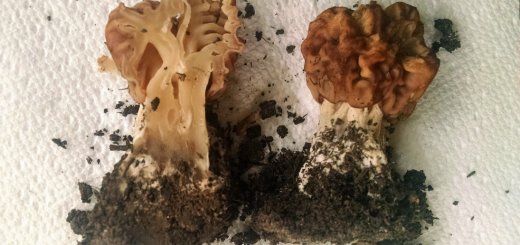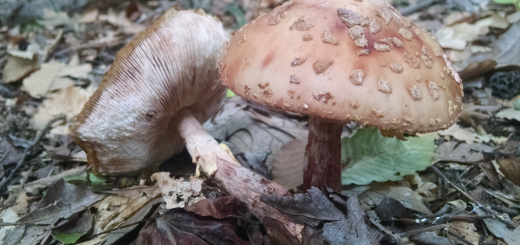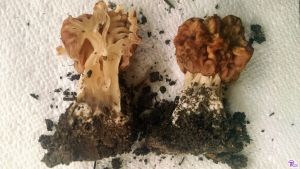#048: Mushroom Morphology: Jelly Fungi
As you might guess, jelly fungi are distinguished by their gelatinous consistency. Their external appearance varies widely, so their texture is the only macroscopic feature that defines this group. These fungi are placed within the phylum Basidiomycota, but they produce basidia (spore-bearing structures) unlike those of most other basidiomycetes (for more on basidia see FFF#013). Because of this, they are often placed in the artificial group of fungi called heterobasidiomycetes. The heterobasidiomycetes also include rusts and smuts, which do not form mushrooms. Jelly fungi produce three different variations on the normal basidium (holobasidium) morphology. Holobasidia have a bulbous, undivided base topped with spore-bearing steritmata. The first variaition on this model is the cruciate basidium. Cruciate basidia have a bulbous base divided into four cells by septa (cell walls). The septa are at right angles to one another, making a cross shape when the basidium is viewed from above. A good way to imagine this is to think of an orange with only four sections*. Each cell produces one sterigma on which a single spore is borne. The sterigmata are often long, wavy cylinders, unlike the short, conical sterigmata of holobasidia. Another type of basidium is the phragmobasidium. Phragmobasidia are rougly cylindrical and are divided into two to four cells by septa. Unlike cruciate basidia, the septa in phragmobasidia are parallel, resulting in a chain of cells. Each cell produces one spore on a short sterigma. The final type of basidium is the tuning fork basidium. These basidia are so named because they are roughly shaped like a Y or tuning fork. Tuning fork basidia are not divided into multiple cells. These basidia only produce two spores, one on each branch of the Y.
There are three main groups of fungi that produce jelly mushrooms: Auriculariales, Tremellomycetes, and Dacrymycetes. The most familiar jelly fungi are found in the order Auriculariales. These include the Judas’ Ear or Wood Ear, Auricularia auricula. This edible mushroom is used in Asian cuisine and is commercially available. The Wood Ear is medium-sized, brown, and shaped roughly like an ear (hemispherical with an irregular, wavy center). One of the most unusual fungi in this group is Pseudohydnum gelatinosum, which produces a mushroom with a cap and teeth, much like the toothed fungi (see FFF#031). Mushrooms in the Auriculariales decompose dead wood and have either phragmobasidia or cruciate basidia. The second most commonly encountered jelly fungi are found in the Tremellomycetes. These include the Witch’s Butter (Tremella mesenterica) and the edible Snow Fungus (Tremella fuciformis, see FFF#023). Tremellomycetes are pathogens of other fungi and produce cruciate basidia. Many Tremellomycetes can grow as both yeast and hyphae. The Dacrymycetes are decomposers of dead wood that typically produce small, yellow mushrooms. These fungi have tuning fork basidia and sometimes produce septate spores. One of the more common Dacrymycetes is Calocera cornea, which looks like a tiny club fungus (roughly cylindrical) fruiting from the side of hardwood logs. Although each individual mushroom is small, it can be easily spotted because of its yellow color and because it usually produces many mushrooms at once. Many Tremellomycetes and Dacrymycetes are tiny and require microscopic examination to make an accurate identification. There are also some ascomycetes that produce gelatinous mushrooms, but they are not included with the jelly fungi. Many slime molds also have a gelatinous phase. However, slime molds are usually not attached to their substrate like fungi are.
Jelly fungi (and other gelatinous mushrooms) are adapted to survive long, dry periods. The fruiting bodies are made up of hyphae with flexible cell walls that allow the cells to expand greatly when water is available. When water is scarce, the cells can contract to form thin, firm sheets that are well suited to withstanding dry conditions. These mushrooms can dry out and rehydrate repeatedly. This allows them to conserve resources by only releasing their spores when water is available. Because of this jelly fungi can often be found during winter thaws when other mushrooms are hard to come by.
The jelly fungi are not a monophyletic group, but they are all descended from a common organism. The Tremellomycetes were the first to diverge from mushroom-forming basidiomycetes (class Agaricomycetes) and are placed in their own class. The Dacrymycetes were the next to diverge and are also placed in their own class. The Auriculariales were the last to diverge and are placed in their own order within the class Agaricomycetes. See the phylogenetic tree at the bottom of the Wikipedia article** for a visual representation of this evolutionary history.
See Further:
http://website.nbm-mnb.ca/mycologywebpages/NaturalHistoryOfFungi/JellyFungi.html
* http://website.nbm-mnb.ca/mycologywebpages/NaturalHistoryOfFungi/BasidiomycotaDiscussion.html#BasidiumTypes (I must give credit to this page for the orange metaphor)
http://www.botany.hawaii.edu/faculty/wong/Bot201/Basidiomycota/Jelly_Fungi.htm
http://www.mushroomexpert.com/jellies.html
http://www.mushroomexpert.com/taxonomy.html
** http://en.wikipedia.org/wiki/Heterobasidiomycetes (I have verified that the phylogenetic tree mentioned earlier is accurate with respect to the heterobasidiomycetes. This article just happens to display the data in the best way.)









![#011: Characteristics of Kingdom Fungi [Archived]](https://www.fungusfactfriday.com/wp-content/themes/hueman/assets/front/img/thumb-small-empty.png)

